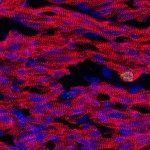Link to Pubmed [PMID] – 17662710
Dev. Biol. 2007 Sep;309(1):97-112
Initiation of the development of the anterior-posterior axis in the mouse embryo has been thought to take place only when the anterior visceral endoderm (AVE) emerges and starts its asymmetric migration. However, expression of Lefty1, a marker of the AVE, was recently found to initiate before embryo implantation. This finding has raised two important questions: are the cells that show such early, preimplantation expression of this AVE marker the real precursors of the AVE and, if so, how does this contribute to the establishment of the AVE? Here, we address both of these questions. First, we show that the expression of another AVE marker, Cer1, also commences before implantation and its expression becomes consolidated in the subset of ICM cells that comprise the primitive endoderm. Second, to determine whether the cells showing this early Cer1 expression are true precursors of the AVE, we set up conditions to trace these cells in time-lapse studies from early periimplantation stages until the AVE emerges and becomes asymmetrically displaced. We found that Cer1-expressing cells are asymmetrically located after implantation and, as the embryo grows, they become dispersed into two or three clusters. The expression of Cer1 in the proximal domain is progressively diminished, whilst it is reinforced in the distal-lateral domain. Our time-lapse studies demonstrate that this distal-lateral domain is incorporated into the AVE together with cells in which Cer1 expression begins only after implantation. Thus, the AVE is formed from both part of an ancestral population of Cerl-expressing cells and cells that acquire Cer1 expression later. Finally, we demonstrate that when the AVE shifts asymmetrically to establish the anterior pole, this occurs towards the region where the earlier postimplantation expression of Cer1 was strongest. Together, these results suggest that the orientation of the anterior-posterior axis is already anticipated before AVE migration.
